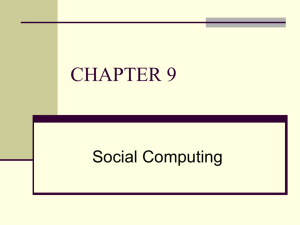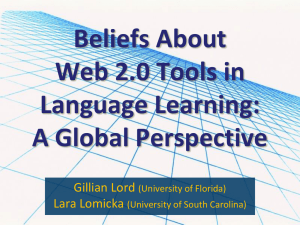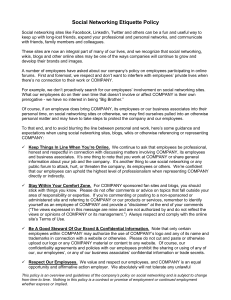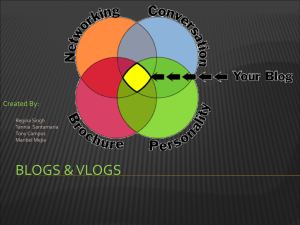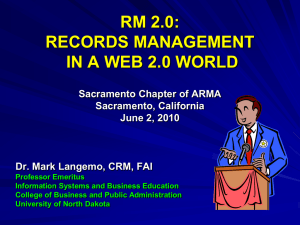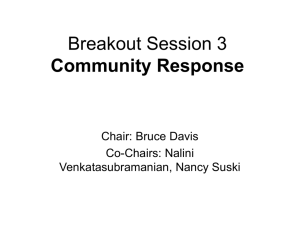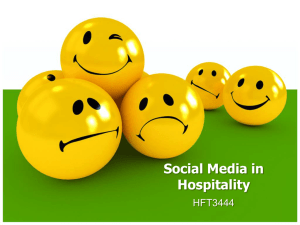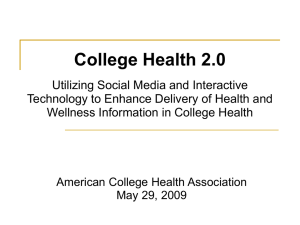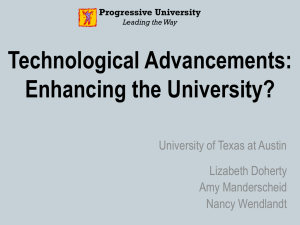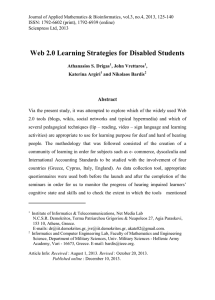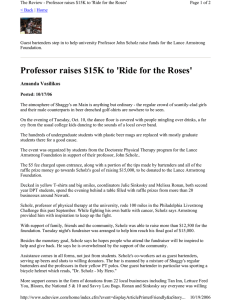Web 2.0 Technology
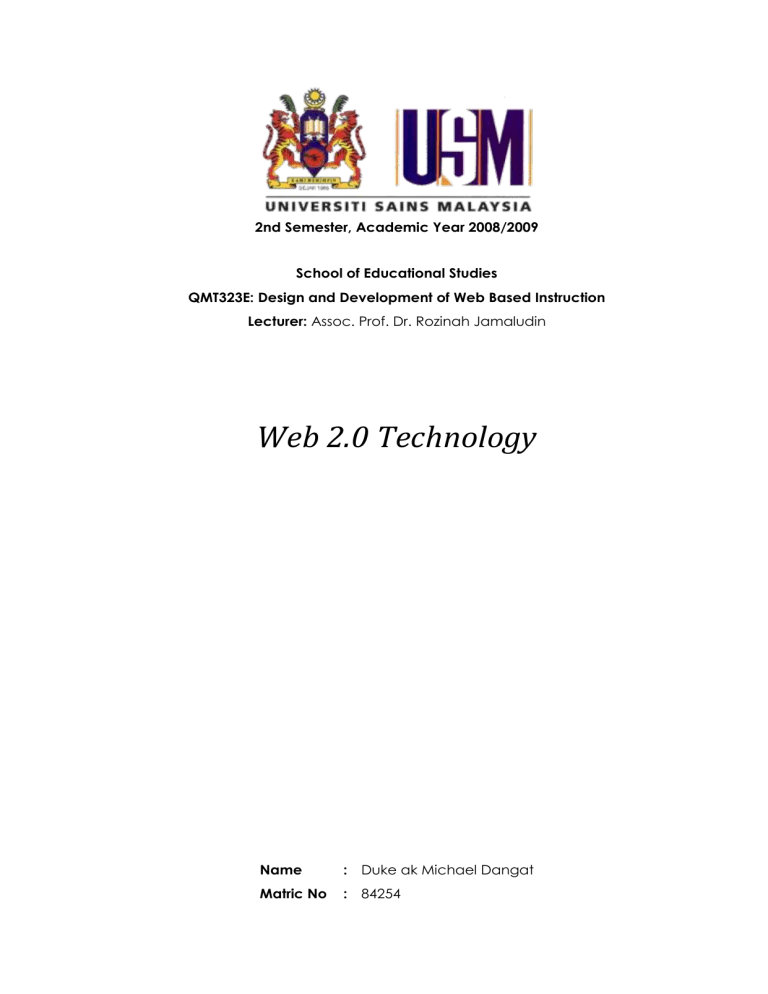
2nd Semester, Academic Year 2008/2009
School of Educational Studies
QMT323E: Design and Development of Web Based Instruction
Lecturer: Assoc. Prof. Dr. Rozinah Jamaludin
Web 2.0 Technology
Name : Duke ak Michael Dangat
Matric No : 84254
Introduction
Before defining Web 2.0, the term Web 1.0 must be understood first. First-generation web-based resources
(including web sites, pages and services) were based on a fairly archaic page markup technology known as
Hypertext Markup Language or HTML. Unlike the rich, interactive software that is installed from CDs or
DVDs, HTML is a static language that simply defines what a page should look like onscreen.
Although programmers have largely succeeded in creating sophisticated web sites that allow a certain degree of interaction (e.g., online banking, movie ticket purchases and vehicle research), there is a limit to what they can do with Web 1.0-based technologies before they become ineffective. This is where Web 2.0 comes in when 1.0 leaves off.
Tim O’Reilly, the founder of a large technology publishing house, open source software proponent and multi–millionaire, coined the phrase Web 2.0 together with a colleague in 2004 (O’Reilly, 2005). Unlike the static Web 1.0, Web 2.0 promises to deliver rich, immersive web-based services that disguise their online backgrounds. Sophisticated online applications such as Google Maps are already changing long-held beliefs about the capabilities of web-based services. Fast-spreading high-speed Internet networks and low cost wireless access are fueling the demand for more sophisticated capabilities.
Web 2.0 is widely acknowledged as a more sophisticated, second-generation approach to the World Wide
Web, leveraging more powerful development tools and platforms to create interactive, collaborative spaces that allow users to more actively participate in the process of creating and sharing content.
Usage
Sometimes called the “New Internet,” Web 2.0 is not a specific technology; rather, it refers to two major paradigm shifts (Scholz, 2008). The one most often touted is “user-generated content,” which more associated with individuals. The second, which is just as important, but more related to business, is “cloud computing”.
User-generated content, comprising blogs, wikis and social networking sites, such as MySpace and
Facebook, let everyone have their say on anything and publish it to the world at large. As Web applications become more sophisticated, people can easily develop elaborate personal Web pages, create a blog, and upload their own opinions, audio and video. Users are supplementing the news by reporting current events sometimes faster and with details often disregarded by the professional news media.
Although millions of opinions and videos only add to our information overload, an important advantage to user-generated content is that truly talented authors, artists, musicians and moviemakers can gain an audience very easily than ever. Word-of-mouth via the Internet is proving to be an effective way of promotion.
In cloud computing, also called “thin client computing”, data and applications are stored on Web servers, and a user has access from any computer via a Web browser. Many believe that cloud computing will eventually replace locally installed computer applications and that turning the Web into a gigantic application server is the ultimate manifestation of Web 2.0.
In time, this could have significant impact on the type of personal computers users choose. Web browsers interpret scripts the same regardless of the hardware and software environment they reside in. As more software is performed from scripts embedded in Web pages, the CPU chips and operating systems become less significant.
Criticism
The exists an argument that “Web 2.0” does not represent a new version of the World Wide Web at all, but merely continues to use so-called “Web 1.0” technologies and concepts (Scholz, 2008). Tim Berners–Lee, the creator of the World Wide Web, is among those who questioned whether one can use the term in a meaningful way, since many of the technology components of “Web 2.0” have existed since the early days of the Web. He described the term “Web 2.0”as a “piece of jargon”:
“Nobody really knows what it means...If Web 2.0 for you is blogs and wikis, then that is people to people. But that was what the Web was supposed to be all along.”
Technologies such as AJAX do not replace underlying protocols like HTTP, but add an additional layer of abstraction on top of them. Many of the ideas of Web 2.0 had already been featured in implementations on networked systems well before the term “Web 2.0” emerged.
Wikis, for example, are not new. The American computer programmer Ward Cunningham started developing WikiWikiWeb in 1994. He installed it on the Internet in 1995. While it is true that social life online drastically increased in scale over time, the Web has always been social. Similarly, user–submitted content started to gain significance not in 2004 but in 1995, when Amazon.com launched. The book selling Web site invited users to write reviews and consumer guides. Beyond this early form of self–publishing, sociality in general has been an aspect of the Web since its inception. (Computer Desktop Encyclopedia, n.d.)
A quick look into the history of the Web will also show that social networking sites are not new.
Classmates.com was founded already in 1995, followed later by SixDegrees.com. A year later, the social networking site Lunarstorm opened as a platform for Swedish, Danish, and British teens and in 1999 the Indian social networking site Sulekha and the African–American social networking site Blackplanet.com was launched.
Real Simple Syndication (RSS), which allows users to subscribe to a dynamic Web site such as a blog, is also a veteran. The first version of RSS was created as a format for syndicating content based on XML by
Netscape in 1999.
Finally, blogging is not a recent breakthrough technology as previously thought. Justin Hall is known to have pioneered it in 1994 by posting exhibitionist rants to his Web page on a daily basis. In 1997 Kuro5hin, a collaborative weblog where users vote for what goes to the front page, was released. Two years later,
Blogger.com and the blogging platform LiveJournal began.
Conclusion
The term Web 2.0, which first came to notice in 2004, refers to more than social media like blogs and wikis.
Although the growth of social media is largely due to the extensive availability of Web 2.0-centric tools and better network access, it promotes Web 2.0 insufficiently to define it simply as a basis for blogging and collaborating. Rather than being a new technology, Web 2.0 is more a shift in culture – one that views the
Internet as a platform for deploying services and not just a simple place to post web pages.
References
O’Reilly, T. (2005). What Is Web 2.0: Design Patterns and Business Models for the Next Generation of
Software . Retrieved March 2, 2009 from O’Reilly: http://www.oreillynet.com/pub/a/oreilly/tim/news/2005/09/30/what-is-web-20.html
Scholz, T. (2008). Market Ideology and the Myths of Web 2.0. First Monday, 13 (3). Retrieved March 4, 2009 from First Monday: http://www.uic.edu/htbin/cgiwrap/bin/ojs/index.php/fm/article/viewArticle/2138/1945
Web 2.0. (n.d.). Computer Desktop Encyclopedia . Retrieved March 2, 2009, from Answers.com Web site: http://www.answers.com/topic/web-2-0-technology
